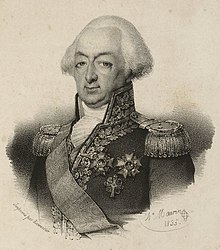François Étienne de Rosily-Mesros
François Étienne de Rosily-Mesros (born January 13, 1748 in Brest , France , † November 12, 1832 in Paris , France) was a French admiral under Napoléon Bonaparte .
Life
François Rosily was the son of field marshal and naval officer François Joseph de Rosily-Mesros and his wife Marie Jeanne Renée Gourio. He joined the navy as a midshipman at the age of 14.
As an officer candidate ( Enseigne ) he drove from 1771 on the La Fortune in the expedition under the command of Yves Joseph de Kerguelen de Trémarec . Kerguelen's expedition was to discover the fabulous country in the south of Terra Australis and take it over for France. His journey led from Madagascar to Java and to Timor and then back to Madagascar on a south course. However, the French could only find the Kerguelen archipelago . Bad weather separated the ships and Rosily returned to France on board the Gros Ventre in 1773. Immediately he set off again, met Kerguelen in Mauritius and returned to Paris in 1774 after a largely unsuccessful journey. He made a detailed report of his trip to the Naval Academy.
In 1778 he was given command of the Coureur , which patrolled the coast and the English Channel. During the battle for the Belle Poule with the British , he was captured. For his bravery he received the cross of the Ordre royal et militaire de Saint-Louis . In 1780 he was released and was given command of the Lively .
In 1782 he was assigned a new ship, the Cléopâtre , with which he took part in the Battle of Gondelour in southern India . The Naval Academy accepted him as a member in 1785.
In 1784 he was promoted to Capitaine de Vaisseau and took over the Vénus , with whom he carried out hydrographic surveys in the Indian Ocean and in the Far East. In 1788 he commanded the Méduse , during the French Revolution he was overseas.
The upheaval in France did not prevent his further rise. At the beginning of 1793 Rosily was promoted to Rear Admiral and married Marie Thérèse de Courbon, the daughter of Admiral Courbon. In 1795 he was appointed director and inspector general of the chart department of the French navy; In 1796 he was appointed vice admiral.
Under the Napoléon Bonaparte regime , Rosily was supposed to replace Admiral Pierre de Villeneuve ; When he learned of his imminent deposition, he left the port of Cádiz and led the united Spanish-French fleet on October 21, 1805 in the battle of Trafalgar , which was a crushing defeat for the Spanish and French. When Rosily arrived in Cádiz, he found only five remaining French ships, which were also badly damaged. He had the remaining fleet made seaworthy again, but was unable to leave the port because of the British blockade.
This stalemate lasted for two and a half years until Napoleon occupied Spain in 1808 to elevate his brother Joseph Bonaparte to the Spanish throne. The Spaniards rose against the occupiers, and the French fleet in the port of Cádiz found itself in a precarious situation: the Spaniards refused access to land, and the British and the remnants of the Spanish fleet harassed the French from the sea. Relief was to come on the one hand by a French fleet, on the other hand from the land side by the army of Pierre Dupont de l'Étang , who was marching towards Cádiz. When the relief fleet did not arrive in early June, Rosily began negotiations with the Spanish officer Tomás de Morla . As a result, the French surrendered their ships to the Spanish and were given safe conduct for Rosily and his chief of staff.
Rosily resumed his work as head of the map office and was made Count of the Empire by Napoleon in 1809 . As a replacement for Louis Antoine de Bougainville , he headed the Bureau de Longitudes , the French surveying office, from October 1811 . In the same year he was appointed chairman of the ship design committee. In 1813 he and Jean Bernard Tarbé de Vauxclaires were commissioned to look for a suitable location for a naval base at the mouth of the Elbe . This plan was no longer realized with the fall of Napoleon in 1814.
Even after the re-establishment of the Bourbons , Rosily remained in office and dignity. Rosily began surveying the French coast and was accepted into the Legion of Honor and, in 1816, the Académie des Sciences . Highly decorated, he retired in 1827 and died in 1832. He was buried in the Père Lachaise cemetery. His name is immortalized on the Arc de Triomphe in Paris .
Web links
- Entry at geneanet.org (English)
- Biographical sketch (French)
Individual evidence
- ^ Anne Lombard Jourdan: Un mémoire inédit de FE de Rosily sur l'île de Timor (1772) , Volume 23, Number 1, pp. 75-104, 1982, accessed on November 22, 2017.
| personal data | |
|---|---|
| SURNAME | Rosily-Mesros, François Étienne de |
| ALTERNATIVE NAMES | Comte de Rosily-Mesros, François Étienne; Count of Rosily-Mesros, François Étienne; Rosily-Meros, François Étienne (alternative spelling) |
| BRIEF DESCRIPTION | French admiral under Napoléon Bonaparte |
| DATE OF BIRTH | January 13, 1748 |
| PLACE OF BIRTH | Brest , France |
| DATE OF DEATH | November 12, 1832 |
| Place of death | Paris , France |
